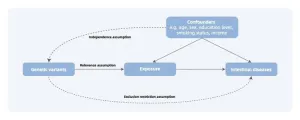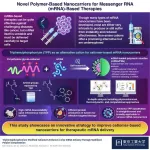(Press-News.org) Newly published research from the University of Houston College of Pharmacy identifies key mechanisms of skeletal muscle regeneration and growth of muscles following resistance exercise. It’s a finding that opens the door to the development of targeted therapies for various muscle disorders, like Muscular Dystrophy, which affect millions of people worldwide.
When it comes to muscles and muscle disorders, the importance of a discovery like this cannot be overstated.
The muscle of muscles
The very core function of life – breathing - is controlled by your skeletal muscles, as is regulation of whole-body metabolism and every movement you make:
Walking
Running
Sitting
Standing
Smiling
And even blinking
In context
Skeletal muscles are formed during embryonic development by the fusion of hundreds of specialized cells called myoblasts. Adult skeletal muscles maintain regenerative capacity, which is attributed to the presence of muscle stem cells, named satellite cells.
After injury, satellite cells undergo several rounds of proliferation followed by their differentiation into myoblasts. These myoblasts once again fuse with each other and to injured myofibers to accomplish muscle regeneration.
In many muscular disorders, this intrinsic capacity of muscles to regenerate is diminished resulting in the loss of muscle mass and function.
The science
UH researchers found that Inositol-requiring enzyme 1, a key signaling protein, is essential for myoblast fusion during muscle formation and growth.
“During muscle regeneration, IRE1 augments the activity of X-box binding protein 1 which in turn stimulates the gene expression of multiple transmembrane proteins required for myoblast fusion,” reports Ashok Kumar, Else and Philip Hargrove Endowed Professor of pharmacy in the Department of Pharmacological and Pharmaceutical Sciences at the UH College of Pharmacy, in EMBO Reports.
According to researchers, increasing the levels of IRE1 or XBP1 in muscle stem cells outside the body, followed by their injection in patients’ muscle tissues will improve muscle repair and reduce the severity of disease.
“We also found that augmenting the levels of IRE1α or XBP1 in myoblasts leads to the formation of myotubes (muscle cells) having an increased diameter,” said Kumar.
That increase in diameter can be significant.
“Size is very important for muscle. Muscle grows only in size, not in number,” said Aniket Joshi, a graduate student in Kumar’s lab and first author on the article. “Muscular people have larger muscle cells. Larger muscles generally work better- can lift more weight, run and walk faster, and improve overall metabolism of the body and prevent various diseases, such as type II diabetes.”
Flexing their muscles
This new research is not the first flex for Kumar’s team. In 2021, research from Kumar’s lab published in the ELife journal described the role of the IRE1α/XBP1 signaling axis in regeneration of healthy skeletal muscle after acute injury and in models of Duchenne Muscular Dystrophy. In this study, they found that IRE1α/XBP1 signaling axis also plays an important cell autonomous role in satellite cells.
Along with Kumar and Joshi, post-doctoral fellow Meiricris Tomaz da Silva and research assistant professor, Anirban Roy conducted the research in Kumar's lab. Other authors on the article from the University of Houston include Micah Castillo, Preethi Gunaratne, Mingfu Wu, Yu Liu, and a former post-doctoral fellow in Kumar’s lab Tatiana E. Koike along with Takao Iwawaki of Kanazawa Medical University, Japan.
END
University of Houston flexes scientific muscle with breakthrough in skeletal muscle regeneration
Discovery by UH College of Pharmacy paves the way for targeted therapies for muscle disorders, offering hope for millions worldwide
2024-07-22
ELSE PRESS RELEASES FROM THIS DATE:
Argonne-led research working toward reducing electronic waste with biodegradable luminescent polymers
2024-07-22
From your car’s navigation display to the screen you are reading this on, luminescent polymers — a class of flexible materials that contain light-emitting molecules — are used in a variety of today’s electronics. Luminescent polymers stand out for their light-emitting capability, coupled with their remarkable flexibility and stretchability, showcasing vast potential across diverse fields of application.
However, once these electronics reach their end use, they are discarded, piling up in landfills or buried underground. Recycling this electronic waste is complex, requiring expensive ...
B cell biohack: USC engineers immune cells to churn out custom antibodies
2024-07-22
USC scientists have discovered a way to turn the body’s B cells into tiny surveillance machines and antibody factories that can pump out specially designed antibodies to destroy cancer cells or HIV, two of medicine’s most formidable foes.
The research, published today in Nature Biomedical Engineering, describes a technique for editing the genes of immune cells called B cells, turbocharging them to fight even the sneakiest invaders. The work is an important advance in harnessing the power of antibodies to treat conditions ranging from Alzheimer’s ...
Understanding how a red seaweed reduces methane emissions from cows
2024-07-22
Methane is the second-largest contributor to climate warming after carbon dioxide, and so scientists have put a lot of attention toward addressing one of the top sources: methane emissions from livestock. In other words, cow burps are bad for the planet.
Farmers add various seaweeds to cow diets as a source of protein, unsaturated fats, and other health-promoting ingredients that provide immediate energy, says Dipti Pitta of the University of Pennsylvania School of Veterinary Medicine, and a 2016 study in Australia found that feeding sheep a species ...
Genome study informs restoration of American chestnut tree
2024-07-22
Native trees adapt to the climate and environmental conditions of their area to survive. Researchers in the College of Natural Resources and Environment in collaboration with the American Chestnut Foundation confirmed this by examining the genome of American chestnut trees sampled throughout the Appalachian Mountain range and grouping the samples according to their specific environmental region.
The research, recently published in the Proceedings of the National Academy of Sciences journal, has the potential to help the ...
Improved efficacy of pembrolizumab when combined with sEphB4-HSA in HPV-negative EphrinB2-positive HNSCC
2024-07-22
“Future development for sEphB4-HSA in HNSCC is likely to focus on patients with HPV-negative disease where there is greatest need to improve on the outcomes with pembrolizumab monotherapy.”
BUFFALO, NY- July 22, 2024 – A new research paper was published in Oncotarget's Volume 15 on July 10, 2024, entitled, “Improved efficacy of pembrolizumab combined with soluble EphB4-albumin in HPV-negative EphrinB2 positive head neck squamous cell carcinoma.”
Patients with relapsed or metastatic head and neck squamous cell carcinoma (HNSCC) after primary local ...
Sleep and social media in tweens: Tips for better rest
2024-07-22
Toronto, ON - The US Surgeon General recently recommended a warning label for social media platforms due to concerns about their impact on youth mental health. The Surgeon General’s Advisory on Social Media and Youth Mental Health highlighted potential links between social media use and poor sleep quality in youth. Considering these concerns, what specific actions can adolescents and parents take to improve sleep?
A new national study, published in the Journal of Adolescent Health, offers insights into screen habits linked with better sleep.
“Ensuring adolescents get enough sleep is vital, as it supports ...
Effect of cash benefits on health care utilization and health
2024-07-22
About The Study: In this randomized study, individuals who received a cash benefit had significantly fewer emergency department visits, including those related to behavioral health and substance use, fewer admissions to the hospital from the emergency department, and increased use of outpatient subspecialty care. Study results suggest that policies that seek to alleviate poverty by providing income support may have important benefits for health and access to care.
Corresponding Author: To contact the corresponding author, Sumit D. Agarwal, M.D., M.P.H., Ph.D., email sagarwal14@bwh.harvard.edu.
To access the embargoed study: Visit our For The Media ...
Mendelian randomization analysis for intestinal disease: Achievement and future
2024-07-22
Traditional epidemiological studies have identified numerous potential risk factors, but observational studies have struggled to establish causal links due to confounding factors and reverse causation. Theoretically avoiding confounding and reverse causation, Mendelian randomization (MR) infers causality, offering novel research perspectives and methods for investigating risk factors of intestinal diseases (Figure 1).
MR research on intestinal disease
Based on MR methodology, researchers have identified lifestyle factors, circulating nutrients, and obesity as being associated with the risk of ...
Improving the design of mRNA-loaded nanocarriers for targeted therapies
2024-07-22
Among the vastly different ways of tackling a disease, controlling the genetic expression of cells is undoubtedly one of the most powerful. Over the past few decades, scientists have come up with dozens of innovative strategies that involve using messenger RNA (mRNA) to ‘force’ cells to build specific proteins. These mRNA-based therapies have recently gained prominence as vaccines against infectious diseases like COVID-19. Additionally, they hold significant potential for treating cancer and genetic disorders.
Since mRNA itself is ...
Chimpanzees gesture back and forth quickly like in human conversations
2024-07-22
When people are having a conversation, they rapidly take turns speaking and sometimes even interrupt. Now, researchers who have collected the largest ever dataset of chimpanzee “conversations” have found that they communicate back and forth using gestures following the same rapid-fire pattern. The findings are reported on July 22 in the journal Current Biology.
“While human languages are incredibly diverse, a hallmark we all share is that our conversations are structured with fast-paced turns of just 200 milliseconds on average,” ...
LAST 30 PRESS RELEASES:
Researchers identify gene that calms the mind and improves attention in mice
Artificial metabolism turns waste CO2 into useful chemicals
Ancient sea anemone sheds light on animal cell type evolution
Begging gene leads to drone food
How climate policies that incentivize and penalize can drive the clean energy transition
Can community awareness campaigns in low-resource areas improve early diagnosis of colorectal cancer?
Stardust study resets how life’s atoms spread through space
Practical education: Clinical scenario-based program development
The impact of family dynamics on eating behaviour – how going home for Christmas can change how you eat
Tracing the quick synthesis of an industrially important catalyst
New software sheds light on cancer’s hidden genetic networks
UT Health San Antonio awarded $3 million in CPRIT grants to bolster cancer research and prevention efforts in South Texas
Third symposium spotlights global challenge of new contaminants in China’s fight against pollution
From straw to soil harmony: International team reveals how biochar supercharges carbon-smart farming
Myeloma: How AI is redrawing the map of cancer care
Manhattan E. Charurat, Ph.D., MHS invested as the Homer and Martha Gudelsky Distinguished Professor in Medicine at the University of Maryland School of Medicine
Insilico Medicine’s Pharma.AI Q4 Winter Launch Recap: Revolutionizing drug discovery with cutting-edge AI innovations, accelerating the path to pharmaceutical superintelligence
Nanoplastics have diet-dependent impacts on digestive system health
Brain neuron death occurs throughout life and increases with age, a natural human protein drug may halt neuron death in Alzheimer’s disease
SPIE and CLP announce the recipients of the 2025 Advanced Photonics Young Innovator Award
Lessons from the Caldor Fire’s Christmas Valley ‘Miracle’
Ant societies rose by trading individual protection for collective power
Research reveals how ancient viral DNA shapes early embryonic development
A molecular gatekeeper that controls protein synthesis
New ‘cloaking device’ concept to shield sensitive tech from magnetic fields
Researchers show impact of mountain building and climate change on alpine biodiversity
Study models the transition from Neanderthals to modern humans in Europe
University of Phoenix College of Doctoral Studies releases white paper on AI-driven skilling to reduce burnout and restore worker autonomy
AIs fail at the game of visual “telephone”
The levers for a sustainable food system
[Press-News.org] University of Houston flexes scientific muscle with breakthrough in skeletal muscle regenerationDiscovery by UH College of Pharmacy paves the way for targeted therapies for muscle disorders, offering hope for millions worldwide






